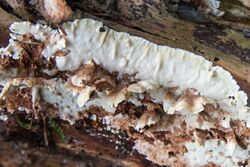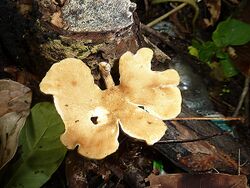Biology:Antrodiella
| Antrodiella | |
|---|---|

| |
| Antrodiella semisupina | |
| Scientific classification | |
| Kingdom: | |
| Division: | |
| Class: | |
| Order: | |
| Family: | |
| Genus: | Antrodiella Ryvarden & I.Johans. (1980)
|
| Type species | |
| Antrodiella semisupina (Berk. & M.A.Curtis) Ryvarden (1980)
| |
Antrodiella is a genus of fungi in the family Steccherinaceae of the order Polyporales.
Taxonomy
Antrodiella was circumscribed by mycologists Leif Ryvarden and I. Johansen in 1980. Of the seven original species it contained, only the type, Antrodiella semisupina, remains in the genus;[1] most of the original species have since been transferred to Flaviporus.
Antrodiella was traditionally placed in the family Phanerochaetaceae until molecular studies were used to determine a more appropriate classification in the Steccherinaceae.[2][3] The genus is a wastebasket taxon, containing "species that share common macroscopic and microscopic characteristics, but are not necessarily related."[4]
Description
The fruitbodies of Antrodiella fungi are either crust-like to effused-reflexed (stretched out on the substrate but with edges curled up to form cap-like structures) in form. They have a waxy and soft fresh texture that becomes dense and hard, and often semitranslucent when dry. If it is present, the cap is narrow and light-coloured, smooth to scrupose (rough with very small hard points). The pore surface is light ochraceous to straw-coloured when dry, with small pores, and the tubes the same colour as the pore surface. The context is white to pale straw-coloured.[1]
Antrodiella has a dimitic hyphal system, containing both generative and skeletal hyphae. The generative hyphae have clamps; the skeletal hyphae are typically narrow, hyaline, and thick-walled to solid. Although they are usually unbranched, in rare cases they have a few scattered branches. Cystidia can be absent or present from the hymenium. Antrodiella spores are small, rarely measuring above 5 µm in their longest dimension, and have a shape that is almost spherical, ellipsoid, or allantoid (sausage-shaped). They are thin-walled, hyaline, and non-amyloid.[1]
Species
A 2008 estimate placed about 50 species in Antrodiella.[5]
- Antrodiella angulatopora Ryvarden (1987)[6]
- Antrodiella brasiliensis Ryvarden & de Meijer (2002)[7] – Brazil
- Antrodiella brunneimontana (Corner) T.Hatt. (2002)[8]
- Antrodiella canadensis (Overh.) Niemelä (2005)[9]
- Antrodiella chinensis H.S.Yuan (2013)[10] – China
- Antrodiella cinnamomea Iturr. & Ryvarden (2010)[11]
- Antrodiella citrea (Berk.) Ryvarden (1984)
- Antrodiella citripileata H.S.Yuan (2012)[12] – China
- Antrodiella dentipora Ryvarden & Iturr. (2003)[13] – Venezuela
- Antrodiella depauperata (Corner) T.Hatt. (2005)
- Antrodiella diffluens (Corner) T.Hatt. (2002)
- Antrodiella ellipsospora (Pilát) Niemelä & Miettinen (2006)
- Antrodiella faginea Vampola & Pouzar (1996)[14] – Europe
- Antrodiella fissiliformis (Pilát) Gilb. & Ryvarden (1987)
- Antrodiella flava (Corner) T.Hatt. (2001)
- Antrodiella flavitubus (Corner) T.Hatt. (2002)
- Antrodiella foliaceodentata (Nikol.) Gilb. & Ryvarden (1993)
- Antrodiella formosana T.T.Chang & W.N.Chou (1998)[15] – Taiwan
- Antrodiella fragrans (A.David & Tortič) A.David & Tortič (1986)
- Antrodiella genistae (Bourdot & Galzin) A.David (1990)
- Antrodiella globospora Núñez & Ryvarden (1999)[16] – Japan
- Antrodiella ichnusana Bernicchia, Renvall & Arras (2005)[17] – Europe
- Antrodiella incrustans (Cooke) Ryvarden (1984)[18]
- Antrodiella indica G.Kaur, Avneet P.Singh & Dhingra (2015) – India[19]
- Antrodiella induratus (Berk.) Ryvarden (1984)[18]
- Antrodiella lactea H.S.Yuan (2013)[20] – China
- Antrodiella leucoxantha (Bres.) Miettinen & Niemelä (2006)[21]
- Antrodiella luteocontexta Ryvarden & de Meijer (2002)[7] – Brazil
- Antrodiella mentschulensis (Pilát ex Pilát) Ryvarden (2014)
- Antrodiella micra Y.C.Dai (2004)[22] – China
- Antrodiella mollis Gibertoni & Ryvarden (2004)[23]
- Antrodiella multipileata Log.-Leite & J.E.Wright (1991)[24] – South America
- Antrodiella murrillii (Lloyd) Ryvarden (1990)
- Antrodiella nanospora H.S.Yuan (2013)[20] – China
- Antrodiella negligenda (Corner) T.Hatt. (2003)
- Antrodiella onychoides (Egeland) Niemelä (1982)
- Antrodiella pachycheiles (Ellis & Everh.) Miettinen & Niemelä (2006)
- Antrodiella pallasii Renvall, Johann. & Stenlid (2000)[25]
- Antrodiella pallescens (Pilát) Niemelä & Miettinen (2006)
- Antrodiella parasitica Vampola (1991)[26] – Europe
- Antrodiella pendulina H.S.Yuan (2012)
- Antrodiella perennis B.K.Cui & Y.C.Dai (2009)[27] – China
- Antrodiella pirumspora Rivoire & Gannaz (2012)[28]
- Antrodiella rata (G.Cunn.) P.K.Buchanan & Ryvarden (1988)
- Antrodiella reflexa Ryvarden & Núñez (1999)[29] – Panama
- Antrodiella romellii (Donk) Niemelä (1982)[30]
- Antrodiella semistipitata Bernicchia & Ryvarden (2007)[31] – Italy
- Antrodiella semisupina (Berk. & M.A.Curtis) Ryvarden (1980)
- Antrodiella serpula (P.Karst.) Spirin & Niemelä (2006)
- Antrodiella stipitata H.S.Yuan & Y.C.Dai (2006)[32] – northeast China
- Antrodiella subcrassa (Rodway & Cleland) P.K.Buchanan & Ryvarden (1993)
- Antrodiella subligativa (Corner) T.Hatt. & Sotome (2013)[33]
- Antrodiella subradula (Pilát) Niemelä & Miettinen (2006)
- Antrodiella thompsonii Vampola & Pouzar (1996)[14] – Europe
- Antrodiella tuberculata Ryvarden & Guzmán (2001)[34] – Mexico
- Antrodiella ussurii Y.C.Dai & Niemelä (1997)[35] – East Asia
- Antrodiella versicutis (Berk. & M.A.Curtis) Gilb. & Ryvarden (1986)
- Antrodiella xanthochroa (Corner) T.Hatt. (2003)
References
- ↑ 1.0 1.1 1.2 Ryvarden, L.; Johansen, I. (1980). A Preliminary Polypore Flora of East Africa. Synopsis Fungorum. Oslo, Norway: Fungiflora.
- ↑ Miettinen, O.; Larsson, E.; Sjökvist, E.; Larsson, K.H. (2010). "Comprehensive taxon sampling reveals unaccounted diversity and morphological plasticity in a group of dimitic polypores (Polyporales, Basidiomycota)". Cladistics 28 (3): 251–270. doi:10.1111/j.1096-0031.2011.00380.x.
- ↑ Miettinen, Otto; Larsson, Ellen; Sjökvist, Elisabet; Larsson, Karl-Henrik (2012). "Comprehensive taxon sampling reveals unaccounted diversity and morphological plasticity in a group of dimitic polypores (Polyporales, Basidiomycota)". Cladistics 28 (3): 251–270. doi:10.1111/j.1096-0031.2011.00380.x. https://www.researchgate.net/publication/256859903.
- ↑ Miettinen, Otto; Larsson, Karl-Henrik (2011). "Sidera, a new genus in Hymenochaetales with poroid and hydroid species". Mycological Progress 10 (2): 131–141. doi:10.1007/s11557-010-0682-5.
- ↑ Kirk, P.M.; Cannon, P.F.; Minter, D.W.; Stalpers, J.A. (2008). Dictionary of the Fungi (10th ed.). Wallingford, UK: CAB International. p. 40. ISBN 978-0-85199-826-8.
- ↑ Ryvarden, Leif (1987). "New and noteworthy polypores from tropical America". Mycotaxon 28 (2): 525–541. https://www.cybertruffle.org.uk/cyberliber/59575/0028/002/0525.htm.
- ↑ 7.0 7.1 Ryvarden, L.; de Meijer, A.A.R. (2002). "Studies in neotropical polypores 14. New species from the state of Paraná, Brazol". Synopsis Fungorum 15: 34–69.
- ↑ Hattori, T. (2002). "Type studies of the polypores described by E.J.H. Corner from Asia and West Pacific Areas. IV. Species described in Tyromyces (1)". Mycoscience 43 (4): 307–315. doi:10.1007/s102670200045.
- ↑ Niemelä, T.; Kinnunen, J.; Larsson, K.H.; Schigel, D.D.; Larsson, E. (2005). "Genus revisions and new combinations of some North European polypores". Karstenia 45 (2): 75–80. doi:10.29203/ka.2005.406. https://www.funga.fi/Karstenia/Karstenia_45-2_2005-1.pdf.
- ↑ Yuan, Hai-Sheng (2013). "Antrodiella chinensis sp. nov., a Chinese representative of the Antrodiella americana complex". Mycological Progress 12 (2): 437–443. doi:10.1007/s11557-012-0852-8.
- ↑ Ryvarden, L.; Iturriaga, T. (2010). "Studies in Neotropical polypores 29. Some new and interesting species from the Andes region in Venezuela". Synopsis Fungorum 27: 78–91.
- ↑ Yuan, Hai‐Sheng; Qin, Wen‐Min (2002). "Antrodiella pendulina and A. citripileata spp. nov. (Basidiomycota, Polyporales) from subtropical and tropical China". Nordic Journal of Botany 30 (2): 201–205. doi:10.1111/j.1756-1051.2011.01234.x.
- ↑ Ryvarden, L.; Iturriaga, T. (2003). "Studies in neotropical polypores 10. New polypores from Venezuela". Mycologia 95 (6): 1066–1077. doi:10.1080/15572536.2004.11833021. PMID 21149014. https://www.cybertruffle.org.uk/cyberliber/59350/0095/006/1066.htm.
- ↑ 14.0 14.1 Vampola, P.; Pouzar, Z. (1996). "Contribution to the knowledge of the Central European species of the genus Antrodiella". Czech Mycology 49 (1): 21–33. doi:10.33585/cmy.49103. http://www.czechmycology.org/_cm/CM491.pdf.
- ↑ Chang, T.T.; Chou, W.N. (1998). "Antrodia lalashana sp. nov. and Antrodiella formosana sp. nov. in Taiwan". Mycological Research 102 (4): 400–402. doi:10.1017/S0953756297005157.
- ↑ Núñez, M.; Ryvarden, L. (1999). "New and interesting polypores from Japan". Fungal Diversity 3: 107–121. https://www.fungaldiversity.org/fdp/sfdp/FD_3_107-121.pdf.
- ↑ Bernicchia, A. (2005). Polyporaceae s.l.. Fungi Europaei. 10. p. 127. ISBN 9788890105753.
- ↑ 18.0 18.1 Ryvarden, L. (1984). "Type studies in the Polyporaceae. 16. Species described by J.M. Berkeley, either alone or with other mycologists from 1856 to 1886". Mycotaxon 20 (2): 329–363. http://www.cybertruffle.org.uk/cyberliber/59575/0020/002/0329.htm.
- ↑ Kaur, G.; Singh, A.P.; Dhingra, G.S. (2015). "Antrodiella indica, a new species from India". Mycotaxon 130 (3): 625–627. doi:10.5248/130.625.
- ↑ 20.0 20.1 Yuan, Hai-Sheng (2014). "Molecular phylogenetic evaluation of Antrodiella and morphologically allied genera in China". Mycological Progress 13 (2): 353–364. doi:10.1007/s11557-013-0921-7.
- ↑ Miettinen, O.; Niemelä, T.; Spirin, W. (2006). "Northern Antrodiella species: the identity of A. semisupina, and type studies of related taxa". Mycotaxon 96: 211–239. http://www.cybertruffle.org.uk/cyberliber/59575/0096/0211.htm.
- ↑ Dai, Y.-C. (2004). "Notes on the genus Antrodiella (Basidiomycota, Aphyllophorales) in China". Mycotaxon 89 (2): 389–398. http://www.cybertruffle.org.uk/cyberliber/59575/0089/002/0389.htm.
- ↑ Gibertoni, T.B.; Ryvarden, L.; Queiros Cavalcanti, M.A. (2004). "Studies in neotropical polypores 18. New species from Brazil". Synopsis Fungorum 18: 44–56.
- ↑ Leite, Clarice Loguercio; Wright, Jorge E. (1991). "New South American pileate polypores (Polyporaceae) from Santa Catarina Island, SC., Brazil". Mycotaxon 41 (1): 167–172. http://www.cybertruffle.org.uk/cyberliber/59575/0041/001/0167.htm.
- ↑ Johannesson, H.; Renvall, P.; Stenlid, J. (2000). "Taxonomy of Antrodiella inferred from morphological and molecular data". Mycological Research 104 (1): 92–99. doi:10.1017/S0953756299008953.
- ↑ Vampola, P. (1991). "Antrodiella parasitica, a new species of polypores" (in cs). Ceská Mykologie 45 (1–2): 10–14. http://www.czechmycology.org/_cm/CM451-2.pdf.
- ↑ Wang, B.; Dai, Y.C.; Cui, B.K.; Du, P.; Li, H.J. (2009). "Wood-rotting fungi in eastern China 4. Polypores from Dagang Mountains, Jiangxi Province". Cryptogamie, Mycologie 30 (3): 233–241.
- ↑ Rivoire, B.; Gannaz, M. (2012). "Antrodiella pirumspora, espèce nouvelle, saprotrophe de Trametella trogii" (in fr). Bulletin de la Société Linnéenne de Lyon 81 (9–10): 277–285.
- ↑ Núñez, Maria; Ryvarden, Leif (1999). "Studies in neotropical polypores 4. New and noteworthy species from Coiba National Park, Panama". Mycotaxon 71: 361–368. https://www.cybertruffle.org.uk/cyberliber/59575/0071/0361.htm.
- ↑ Niemelä, T. (1982). "Taxonomic notes on the polypore genera Antrodiella, Daedaleopsis, Fibuloporia and Phellinus". Karstenia 22: 11–12. doi:10.29203/ka.1982.208. http://www.funga.fi/Karstenia/Karstenia%2022-1%201982-3.pdf.
- ↑ Bernicchia, Annarosa; Ryvarden, Leif; Gibertoni, Tatiana Baptista (2007). "Antrodiella semistipitata (Basidiomycetes, Polyporales) a new species from Italy". Mycotaxon 99: 231–238. http://www.cybertruffle.org.uk/cyberliber/59575/0099/0231.htm.
- ↑ Yuan, H.S.; Li, J.; Huang, M.Y.; Dai, Y.C. (2006). "Antrodiella stipitata sp. nov. from Heilongjiang Province, northeast China, and a critical checklist of polypores from the area". Cryptogamie, Mycologie 27 (1): 21–29.
- ↑ Hattori, T.; Sotome, K. (2013). "Type studies of the polypores described by E.J.H. Corner from Asia and West Pacific Areas VIII. Species described in Trametes (2)". Mycoscience 54 (4): 297–308. doi:10.1016/j.myc.2012.10.008.
- ↑ Ryvarden, L.; Guzmán, G. (2001). "Studies in neotropical polypores 12. New and noteworthy polypores from Mexico". Mycotaxon 78: 245–256. http://www.cybertruffle.org.uk/cyberliber/59575/0078/0245.htm.
- ↑ Dai, Yu-Cheng; Niemelä, Tuomo (1997). "Changbai wood-rotting fungi 6. Study on Antrodiella, two new species and notes on some other species". Mycotaxon 64: 67–81. http://www.cybertruffle.org.uk/cyberliber/59575/0064/0067.htm.
Wikidata ☰ Q387828 entry
 |



